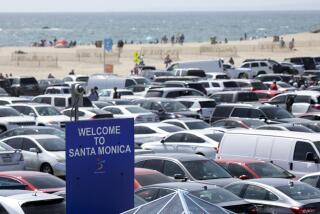Try to Steer Clear of Race’s Starting Area
- Share via
It’s hardly earthshaking sailing news, but it could save you a maximum fine of up to $500,000 and imprisonment of up to one year:
Don’t operate your vessel in a negligent manner so as to endanger life, limb or property in a regulated area off Newport Beach from noon until 4 p.m. Saturday.
In the very least, if you enter the regulated area in an unauthorized vessel, you may be subject to a civil penalty of up to $500.
These special local Coast Guard regulations apply to the starting area of the 38th Annual Newport to Ensenada Race, in which about 700 sailboats, from 24 to 85 feet, will participate. The regulated area lies just west, and a bit seaward, from the end of the harbor entrance jetties. If you should wish to view the start of the race in an unauthorized vessel (one not registered with the sponsor--the Newport Ocean Sailing Assn.--then you should settle down with your chart and work out the following coordinates that mark the boundaries of the regulated area:
33 degrees 35.3 minutes North, 117 degrees 53.3 minutes West; 33 degrees 34.9’ Nds, 117 degrees 53.3’ W; 33 degrees 34.9’ N, 117 degrees 54.5’ W; and 33 degrees 35.3’ N, 117 degrees 54.5’ W.
Come to think of it, it’ll mean a lot less bother if you view the start from a Corona del Mar or Newport Beach bluff--or line the waterfront of the Balboa Peninsula for a more intimate, eye-level view.
Now for something rather more earthshaking . . .
Dr. Francis Shepard is a retired professor of submarine geology at Scripps Institution of Oceanography, and is often considered to have created the field. Gerry Kuhn is a staff marine geologist at Scripps and is considered one of the rising figures in the field. The pair have written a book, “Sea Cliffs, Beaches, and Coastal Valleys of San Diego County: Some Horrifying Implications,” University of California Press.
Kuhn and Shepard document an alarming view of erosion and geologic instability in San Diego’s coastal bluffs and river valleys. What’s more, they have used techniques involving analysis of tree rings, historical surveys, newspaper accounts and records of volcanic activity to argue that the climate of Southern California has been unusually benign during the past 40 years.
According to Jim McGrath, who reviewed their book for “California WaterfrontAge,” the authors contrast recent climatic conditions with the harsh storms of the 19th Century. They conclude that a recurrence of this historic condition would be disastrous to the the economy of Southern California coastal valley and lowlands.
They predict that we coastal residents are in for some real weather batterings and shakings sometime in the vague future because the climate and the geology are preparing for the worst.
Saturday and Sunday, the Eagle Syndicate of the Newport Harbor Yacht Club will host a race series against a rival international syndicate off the Long Beach coast.
Challenging the syndicate will be the Yacht Club Italiano of Genoa, Italy, which won the 12-Meter World Championship last year. The Italian syndicate will race its 12-Meter Victory ’83 against Eagle’s laboratory 12-Meter, Magic. Both vessels are docked at the Long Beach Marina Shipyard, Alamitos Bay. At 10:30 a.m. both days, the yachts will be towed off the coast. The races will begin at noon.
This competition between two international syndicates puts crews and equipment under the pressures of race conditions. This is particularly important for the Eagle crew because Magic is fitted with a newly designed winged keel that has yet to be tested in formal competition.


